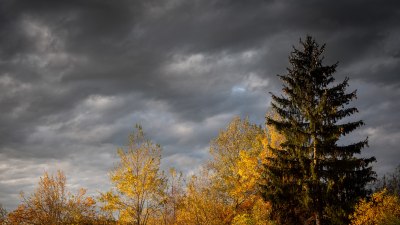Why Rainbows Form in Circles from Airplanes
Discover the science behind circular rainbows seen from airplanes and enhance your understanding of this beautiful phenomenon.

Rainbows are one of nature's most dazzling spectacles, captivating onlookers with their vibrant colors and arc-like shapes. However, the phenomenon of seeing circular rainbows from an airplane presents an intriguing twist that many might not be familiar with. In this article, we will explore the science behind how rainbows form, why they appear circular at high altitudes, and the conditions necessary for this breathtaking sight.
The Basics of Rainbow Formation
To understand why circular rainbows can be seen from an airplane, we first need to grasp the basics of how rainbows form. A rainbow occurs when sunlight interacts with raindrops in the atmosphere. This optical phenomenon involves three main processes: refraction, reflection, and dispersion.
When sunlight enters a raindrop, the light bends or refracts due to the change in medium from air to water. This bending of light causes the various colors within the light spectrum to separate. Light then reflects off the internal surface of the raindrop before exiting back into the atmosphere, where it refracts again. This double refraction, along with the internal reflection, leads to the emergence of a rainbow.
The Circular Nature of Rainbows
Rainbows typically appear as arcs because of the position of the observer on the ground. The circular shape of a rainbow originates from the spherical shape of the raindrops refracting light. However, when viewed from the ground, only the upper half of the circle is visible above the horizon. The rest of the circle is hidden by the earth.
From an airplane, the perspective changes dramatically. Since airplanes often fly at altitudes that exceed the height of most rain clouds, passengers may find themselves in a rare position to see the complete circle of the rainbow. Instead of the semi-circular arcs typically seen from the ground, an airplane passenger can catch sight of the entire circumference of the rainbow—creating a captivating and surreal visual experience.
Conditions Necessary for Circular Rainbows
While the phenomenon of circular rainbows is fascinating, certain conditions must be met for them to be observable from an airplane. First and foremost, the presence of raindrops is essential. Rainbows occur primarily after or during rain, when sunlight breaks through the clouds and illuminates the rain droplets.
The angle of sunlight is also critical. The sunlight needs to strike the droplets at a specific angle—typically around 42 degrees from the horizon—for a rainbow to form. This angle ensures that the refracted light exits the raindrop in such a way that it can be seen from a specific vantage point. As a result, the most vivid and complete rainbows are commonly observed when the sun is low in the sky, such as during sunrise or sunset.
Additionally, the presence of clouds can influence the visibility of circular rainbows from an airplane. Flying through a cloud or close to one can enhance the likelihood of seeing these rainbows, especially if the sun breaks through after rain in the vicinity.
The Role of Altitude and Perspective
Altitude plays a significant role in the rainbow viewing experience. From a standard height, such as that of an airplane, the equitable distribution of rain droplets below allows for the comprehensive view of the circular rainbow. Furthermore, the perspective gained from such altitude is critical to the appearance of the rainbow.
While standing on the ground, a person's eyesight is limited by the horizon, blocking the lower part of the circle. In contrast, flying offers a tremendous vantage point where the entire phenomenon of the circular rainbow is able to be appreciated in its full splendor.
Monks, Planes, and Natural Phenomena
The phenomenon of circular rainbows has not only fascinated airplane passengers but has also left impressions on cultural history. In various traditions, rainbows symbolize peace and hope. They have been embedded in mythology, art, and even scientific inquiry for centuries. The mystical and sacred connections to rainbows can be seen in cultures across the world.
One particular inspiring story from the 1940s involves a group of monks in a remote monastery. After a heavy rainstorm, they noticed an awe-inspiring circular rainbow surrounding the sun. This event sparked deep reflections that the monks conveyed through art, meditation, and teachings—a reminder of the beauty that can emerge in nature. Such accounts exemplify how the visual phenomenon can invoke strong emotional responses and inspire creativity.
Photographic Opportunities
For those lucky enough to witness a circular rainbow while flying, the opportunity for photography arises. Capturing an entire circle of a rainbow is not an everyday occurrence, making for a unique and memorable image. To take good photographs of this natural wonder, the use of a wide-angle lens can enhance the ability to frame not just the rainbow, but also the sky and surroundings.
Some tips for photographing a circular rainbow include ensuring that the sunlight is positioned behind the observer, utilizing a fast shutter speed to avoid blurriness, and adjusting to capture the rainbow's vivid colors. Digital editing can also enhance the vibrancy of the rainbow colors for those looking to share their experience online or in printed form.
In conclusion, the sight of a circular rainbow from an airplane exemplifies the intricate interplay between sunlight, water droplets, atmospheric conditions, and perspective. While typical rainbows present a half-circle to those on the ground, flying at high altitudes opens up a view of the full circular formation, turning a simple meteorological phenomenon into a mesmerizing display. Whether viewed from a commercial airline or a private plane, these ethereal circles offer a unique connection to nature's beauty—reminding us of the wonder and intricacies of the natural world. So, the next time you fly through rain or see clouds dispersing, keep an eye out for the magical circular rainbow, as it's an experience you won’t want to miss.











